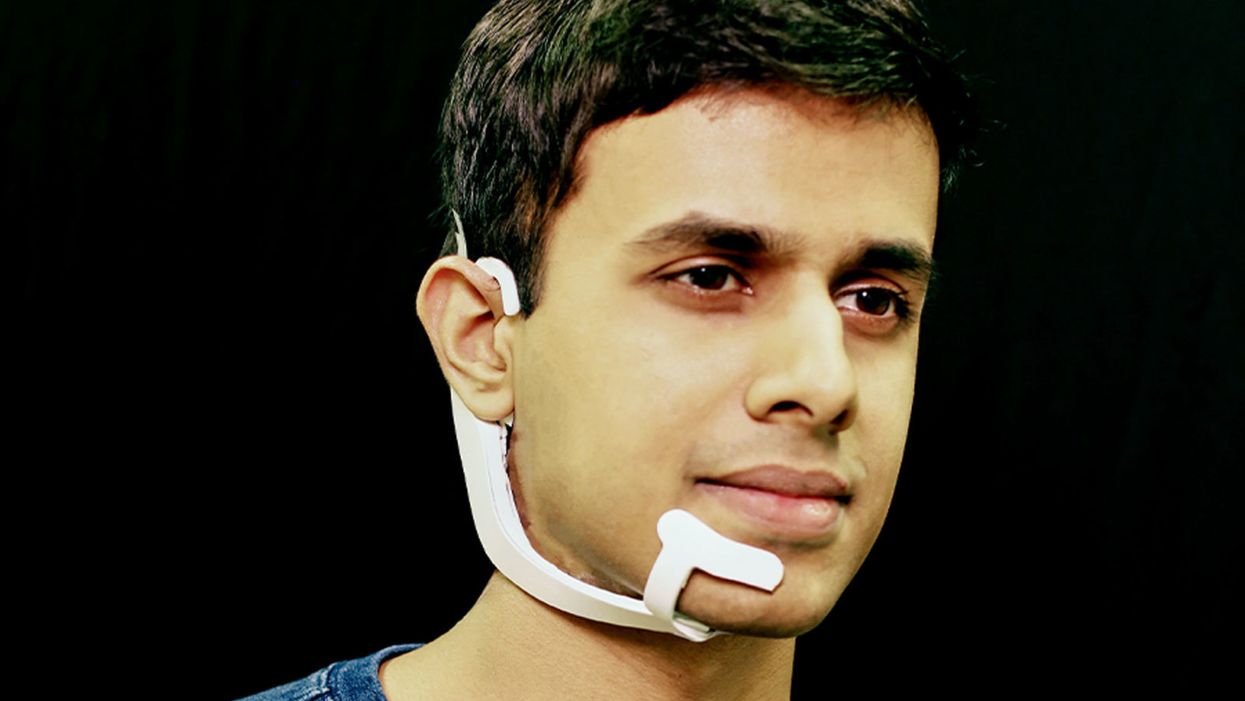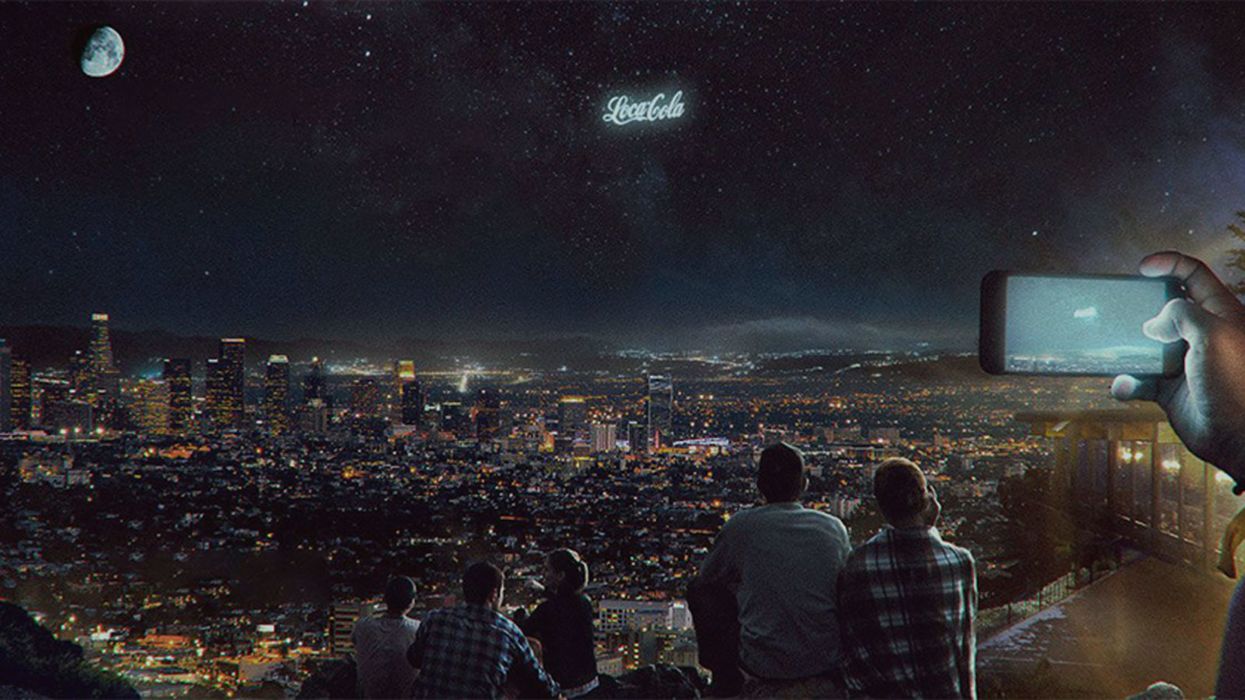“Siri, Read My Mind”: A New Device Lets Users Think Commands
Arnav Kapur, a researcher in the Fluid Interfaces Group at MIT, wears an earlier prototype of the AlterEgo. A newer version is more discreet.
Sometime in the near future, we won't need to type on a smartphone or computer to silently communicate our thoughts to others.
"We're moving as fast as possible to get the technology right, to get the ethics right, to get everything right."
In fact, the devices themselves will quietly understand our intentions and express them to other people. We won't even need to move our mouths.
That "sometime in the near future" is now.
At the recent TED Conference, MIT student and TED Fellow Arnav Kapur was onstage with a colleague doing the first live public demo of his new technology. He was showing how you can communicate with a computer using signals from your brain. The usually cool, erudite audience seemed a little uncomfortable.
"If you look at the history of computing, we've always treated computers as external devices that compute and act on our behalf," Kapur said. "What I want to do is I want to weave computing, AI and Internet as part of us."
His colleague started up a device called AlterEgo. Thin like a sticker, AlterEgo picks up signals in the mouth cavity. It recognizes the intended speech and processes it through the built-in AI. The device then gives feedback to the user directly through bone conduction: It vibrates your inner ear drum and gives you a response meshing with your normal hearing.
Onstage, the assistant quietly thought of a question: "What is the weather in Vancouver?" Seconds later, AlterEgo told him in his ear. "It's 50 degrees and rainy here in Vancouver," the assistant announced.
AlterEgo essentially gives you a built-in Siri.
"We don't have a deadline [to go to market], but we're moving as fast as possible to get the technology right, to get the ethics right, to get everything right," Kapur told me after the talk. "We're developing it both as a general purpose computer interface and [in specific instances] like on the clinical side or even in people's homes."
Nearly-telepathic communication actually makes sense now. About ten years ago, the Apple iPhone replaced the ubiquitous cell phone keyboard with a blank touchscreen. A few years later, Google Glass put computer screens into a simple lens. More recently, Amazon Alexa and Microsoft Cortana have dropped the screen and gone straight for voice control. Now those voices are getting closer to our minds and may even become indistinguishable in the future.
"We knew the voice market was growing, like with getting map locations, and audio is the next frontier of user interfaces," says Dr. Rupal Patel, Founder and CEO of VocalID. The startup literally gives voices to the voiceless, particularly people unable to speak because of illness or other circumstances.
"We start with [our database of] human voices, then train our deep learning technology to learn the pattern of speech… We mix voices together from our voice bank, so it's not just Damon's voice, but three or five voices. They are different enough to blend it into a voice that does not exist today – kind of like a face morph."
The VocalID customer then has a voice as unique as he or she is, mixed together like a Sauvignon blend. It is a surrogate voice for those of us who cannot speak, just as much as AlterEgo is a surrogate companion for our brains.
"I'm very skeptical keyboards or voice-based communication will be replaced any time soon."
Voice equality will become increasingly important as Siri, Alexa and voice-based interfaces become the dominant communication method.
It may feel odd to view your voice as a privilege, but as the world becomes more voice-activated, there will be a wider gap between the speakers and the voiceless. Picture going shopping without access to the Internet or trying to eat healthily when your neighborhood is a food desert. And suffering from vocal difficulties is more common than you might think. In fact, according to government statistics, around 7.5 million people in the U.S. have trouble using their voices.
While voice communication appears to be here to stay, at least for now, a more radical shift to mind-controlled communication is not necessarily inevitable. Tech futurist Wagner James Au, for one, is dubious.
"I'm very skeptical keyboards or voice-based communication will be replaced any time soon. Generation Z has grown up with smartphones and games like Fortnite, so I don't see them quickly switching to a new form factor. It's still unclear if even head-mounted AR/VR displays will see mass adoption, and mind-reading devices are a far greater physical imposition on the user."
How adopters use the newest brain impulse-reading, voice-altering technology is a much more complicated discussion. This spring, a video showed U.S. House Speaker Nancy Pelosi stammering and slurring her words at a press conference. The problem is that it didn't really happen: the video was manufactured and heavily altered from the original source material.
So-called deepfake videos use computer algorithms to capture the visual and vocal cues of an individual, and then the creator can manipulate it to say whatever it wants. Deepfakes have already created false narratives in the political and media systems – and these are only videos. Newer tech is making the barrier between tech and our brains, if not our entire identity, even thinner.
"Last year," says Patel of VocalID, "we did penetration testing with our voices on banks that use voice control – and our generation 4 system is even tricky for you and me to identify the difference (between real and fake). As a forward-thinking company, we want to prevent risk early on by watermarking voices, creating a detector of false voices, and so on." She adds, "The line will become more blurred over time."
Onstage at TED, Kapur reassured the audience about who would be in the driver's seat. "This is why we designed the system to deliberately record from the peripheral nervous system, which is why the control in all situations resides with the user."
And, like many creators, he quickly shifted back to the possibilities. "What could the implications of something like this be? Imagine perfectly memorizing things, where you perfectly record information that you silently speak, and then hear them later when you want to, internally searching for information, crunching numbers at speeds computers do, silently texting other people."
"The potential," he concluded, "could be far-reaching."
Goodnight, Moon. Goodnight, Sky Advertisement.
A rendering of what a sky advertisement would look like.
Imagine enjoying a romantic night stargazing, cozying up for the evening – and you catch a perfectly timed ad for Outback Steakhouse.
Countries have sovereignty over their airspace, but the night sky itself is pretty much an open field.
That's the vision of StartRocket, a Russian startup planning to put well-lit advertisements into outer space. According to a recent interview, StartRocket says its first client is PepsiCo.
The Lowdown
Launching at twilight during the early morning or early evening, the ads will be on cubesats – 10 cm square metallic boxes traditionally used in space. The attached Mylar sails will reflect light from the rising or setting sun, making the ad appear like an "orbital billboard."
The advertisements will need all the solar power they can get: According to a 2016 report, 80 percent of the world and 99 percent of America and Europe experience light pollution at night. Showing advertisements in, say, Wyoming will be much easier than attracting attention in Midtown Manhattan – and risks adding a considerable amount of light pollution to an already overburdened night sky.
Next Up
The StartRocket advertising program is set to begin in 2021. The most recent rate is $20,000 for eight hours of advertising space.
But first, StartRocket has to win over consumers, regulators and space activists.
"I don't see it taking off now," says TED Fellow and University of Texas, Austin Associate Professor Dr. Moriba Jah. Jah is the creator of Astriagraph, an interactive tool to help monitor space junk orbiting Earth. "In general, the space community is anathema to advertisements from orbit to people on the ground… The global astronomy community will be fighting it tooth and nail."
Jah notes SpaceX's launch of 60 satellites last month. "Astronomers were up in arms since they are so bright, you can see them with the naked eye." It got to the point where Elon Musk had to defend himself to the astronomy community on Twitter.
Open Questions
Startups come and go, especially those that are looking for funding. StartRocket is in both categories. Frankly, it's unclear if the ads will actually launch two years from now.
Space advertisements are more likely to be the future for less regulated and financially strapped areas.
The regulatory hurdles are just as unknown. According to Jah, countries have sovereignty over their airspace (think planes, balloons and drones), but the night sky itself is pretty much an open field. This doesn't remove the political ramifications, though, and any American-based launches would have to contend with the FCC, since it regulates advertisements, and the FAA, since it regulates flight.
Carbon credits-style redemptions may help balance out the potential environmental and political damage done by sky ads. It isn't a coincidence that space pioneers Musk, Jeff Bezos, and Richard Branson succeeded at other ventures first, giving them considerably deep pockets to survive red tape – something StartRocket's team doesn't have at the moment.
Space advertisements are more likely to be the future for less regulated, financially strapped areas. Depending on how ad companies negotiate with the local governments, it's easy to picture Kolkata with an "Enjoy Coke" advertisement blaring during a Ganges sunset.
"In rural places, it would be like having another moon," Jah says. "People would say the rich are now taking the sky away from us."
The Grim Reaper Can Now Compost Your Body
An artist's rendering of a future Recompose facility in Washington state, with reusable modular vessels that convert human remains to soil.
Ultra-green Seattle isn't just getting serious about living eco-friendly, but dying that way, too. As of this week, Washington is officially the first state to allow citizens to compost their own dead bodies.
Their bodies, including bones, were converted into clean, odorless soil free of harmful pathogens.
The Lowdown
Keep in mind this doesn't mean dumping your relative in a nearby river. Scientists and organizations have ways to help Mother Nature process the remains. For instance, the late actor Luke Perry reportedly was buried in a mushroom suit. Perry's garment is completely biodegradable and the attached microorganisms help the decomposition process cleanly and efficiently.
A biodegradable burial requires only a fraction of the energy used for cremation and can save a metric ton of CO2. The body decomposes in about a month. Besides a mushroom suit, another option coming down the pike in Washington state is to have your body converted directly into soil in a special facility.
A pilot study last summer by a public benefit corporation called Recompose signed up six terminally ill people who donated their remains for such research. Their bodies, including bones, were converted into clean, odorless soil free of harmful pathogens. That soil—about a cubic yard per person--could then be returned after 30 days to the subjects' families.
Green burials open the door to creative memorials. A tree or garden could be planted with your soil. This method provides a climate-friendly alternative to traditional funerals, circumventing toxic embalming fluid, expensive casket materials and other ecological overhead. The fertile soil could also be given to conservationist organizations.
Next Up
The new legislation in Washington will take effect May 1, 2020. The Pacific Northwest state has one of the highest cremation rates in the nation at 78 percent, only second to Nevada. Rising climate change and increased interest in death management will only speed this discussion to the forefront in other states.
A biodegradable burial requires only a fraction of the energy used for cremation and can save a metric ton of CO2.
It's also worth noting Perry wasn't buried in Washington State, but in Tennessee. It is unknown where exactly he was laid to rest, nor if it was done under a legal precedent or special exception.
According to the Green Burial Council, each state varies on how and where you can bury someone. Home burials are usually legal, but to do so requires establishing an official cemetery area on the property. How someone is buried has even more dynamic legislation. There will be new discussions about how neighbors contend with nearby decomposing bodies, legal limitations to private burial techniques, and other issues never addressed before in modern mainstream America.
Open Questions
It's unclear if green burials will be commonplace for those with less financial means or access. Mushroom suits average a couple thousand dollars, making them more expensive than a low-end casket. There are also the less obvious expenses, including designating the place of burial, and getting proper burial support and guidance. In short, you likely won't go to the local funeral home and be taken care of properly. It is still experimental.
As for "natural organic reduction" (converting human remains to soil in reusable modular vessels), Recompose is still figuring out its pricing for Washington residents, but expects the service to cost more than cremation and less than a conventional burial.
For now, environmentally sustainable death care may be comparable to vegetarianism in the 1970s or solar paneling in the 1980s: A discussion among urbanites and upwardly-mobile financial classes, but not yet an accessible option for the average American. It's not a coincidence that the new Washington law received support in Seattle, one of the top 10 wealthiest cities in America. A similar push may take off in less affluent areas if ecological concerns drive a demand for affordable green burial options.
Until then, your neighborhood mortician still has the death business on lock.


